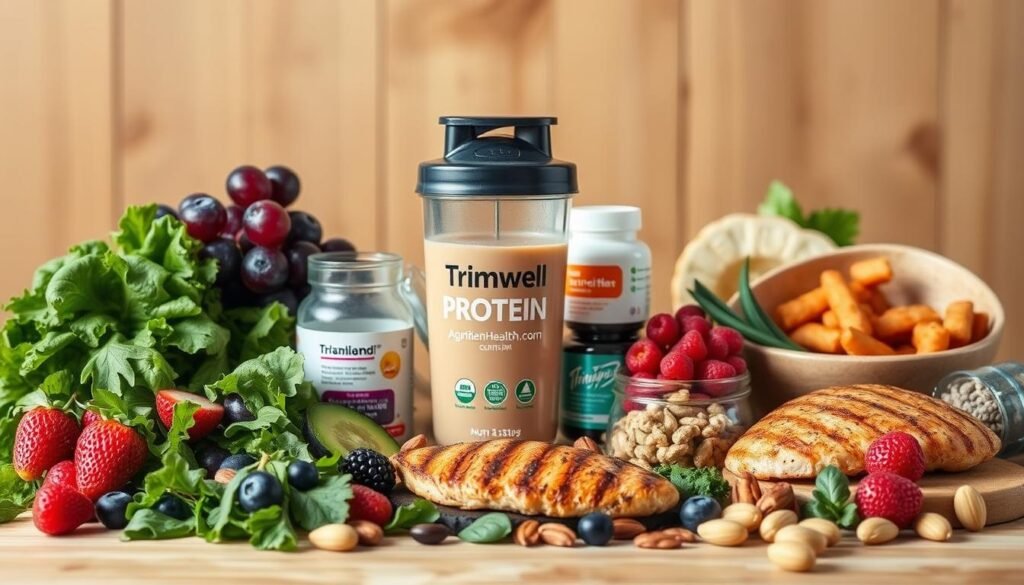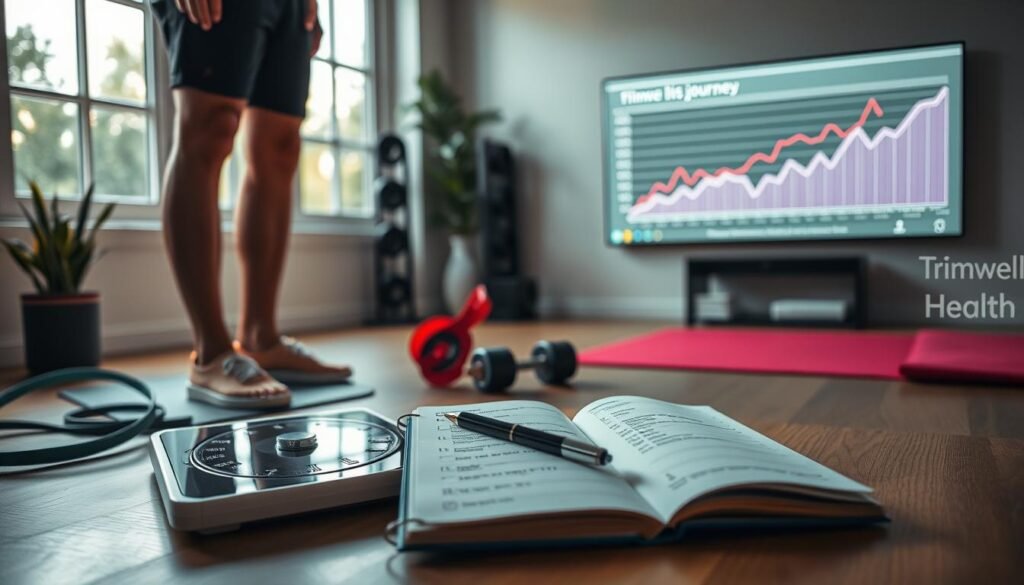Top Bodyweight Exercises for Over 40s | Stay Fit
As we get older, staying active becomes more important. Many of us miss our younger days when staying fit was easy. Bodyweight exercises can help us feel young again, fitting our changing bodies.
Whether you’re starting again or looking for new challenges, the best bodyweight exercises for over 40 are great. They help you stay fit without needing a gym or special equipment. It’s never too late to get strong and feel alive again!
Key Takeaways
- Bodyweight exercises are perfect for boosting strength after 40.
- Low-impact workouts protect aging joints and keep you fit.
- Bodyweight training is easy for everyone because it’s convenient and accessible.
- Having a good routine can lead to big health benefits.
- Knowing about nutrition is key for a good fitness plan.
Introduction to Bodyweight Exercises for Over 40s
When you hit your 40s, staying fit is key. Bodyweight workouts are great for boosting strength and health. They don’t need heavy equipment, making them perfect for older adults.
Bodyweight exercises are flexible and can be done anywhere. This is great for people with busy lives. They offer a wide range of movements for all fitness levels, helping everyone stay fit.
These workouts help with joint issues and muscle loss common in older adults. They make fitness a long-term goal, keeping you healthy and injury-free.
In short, bodyweight exercises are a powerful tool for those over 40. They improve strength and fitness safely and flexibly.
Why Bodyweight Exercises are Ideal for Over 40 Fitness
As people get older, they might lose muscle and face hormone changes. This can affect their health. Strength training for over 40 can help fight these changes and keep you healthy. Bodyweight exercises are great because they’re easy on your joints, making them safer.
These exercises make you stronger for daily tasks like lifting and bending. They also help your joints and support recovery. This means you can stay active without hurting yourself.
Adding bodyweight exercises to your routine is a smart move. You can adjust the moves to fit your level, helping you feel more confident. This way of training is good for your health and meets the needs of people over 40.
Benefits of Bodyweight Workouts
Bodyweight workouts are great for people over 40. They are easy to do and help you get fit. They are perfect for anyone, even if you’re new to working out.
Low Impact on Joints
Bodyweight exercises are gentle on your joints. This is good as you get older. They help you build muscle without hurting your joints.
Improves Functional Strength
These workouts make you stronger for everyday tasks. They help you move better and do things easier. This makes life simpler and safer.
Convenience and Accessibility
Bodyweight workouts are easy to do anywhere. You don’t need any special equipment. This makes it easy to stay active, no matter where you are.
Best Bodyweight Exercises for Over 40
For those over 40, adding bodyweight exercises to your routine is great. These exercises boost strength, stability, and fitness.
Wall-Sit Holds with Calf Raises
This exercise works your thighs and calves and helps with balance. Stand with your back against a wall, then slide down until your knees are bent at a right angle. Keep your back flat against the wall.
Hold this pose while raising your heels for calf raises. Do 3 sets of 30 seconds, then 10 calf raises. Make sure to keep the right form to avoid injury.
Pistol Squats
Pistol squats are tough but good for your legs, core, and glutes. Stand on one leg and extend the other leg forward. Lower yourself down, keeping your extended leg off the ground.
Slowly go back up to the start. Start with 3 sets of 5-8 reps per leg. Keep your balance and control.
Plank to Push-Up
This move strengthens your core and upper body. Start in a plank position, with your forearms on the ground. Your body should be straight.
Move to a push-up by pressing up with your hands, one side at a time. Then, lower back to the plank. Do 3 sets of 10 reps. Focus on keeping the right form to avoid injury.
How to Structure Your Bodyweight Workout Routine
Creating a good bodyweight workout routine needs careful planning. You should mix up the intensity, how often you work out, and rest. Make sure to include exercises for both your upper and lower body. This helps work out different muscle groups.
Try alternating between days for upper and lower body exercises. For example, do lower body workouts on Day 1. This can include wall-sit holds and standing glute kickbacks. Then, on Day 2, do upper body exercises like dips and plank to push-up combos. This helps muscles grow and recover.
Keep your workouts interesting by changing them up. Do 3-4 sets of each exercise. Adjust how many times you repeat it based on your strength. As you get stronger, make the exercises harder, like single-leg dips.
Remember to add core exercises too. Doing bird dogs can improve balance and strength. Check out this resource for tips on making your workouts better.
Lastly, rest is key. Muscles need time to heal after hard workouts. A good routine has variety and makes sure you rest enough.
Nutrition for Supporting Age-Friendly Exercises
Good nutrition for fitness is key for your bodyweight exercises, more so for those over 40. Eating high-quality protein helps muscles repair and grow. This makes your workouts more effective.
Adding lean meats, beans, and dairy to your diet can speed up recovery. This is important for keeping up with your exercise routine.
It’s also important to eat balanced meals. These should have carbs, healthy fats, and vitamins. This mix boosts your energy for workouts and keeps you healthy.
Calcium and vitamin D are also important. They help keep your bones strong. This is vital for staying active.
Don’t forget to drink plenty of water. It helps with digestion and muscle recovery. Drinking enough water keeps you performing well and avoids feeling tired.

In short, good nutrition for fitness supports your bodyweight training. It also helps you stay active for a long time. This keeps you healthy and strong.
Safety Modifications for Bodyweight Movements
Making your workouts safer is key. It lets everyone enjoy their exercises without worry. Here are some tips to help:
- Start with warm-ups to prepare your muscles and joints.
- Use a chair or wall for support in tough moves like pistol squats.
- Change how far you move in exercises if your joints hurt.
- Do movements slowly to keep balance and focus.
These changes help everyone stay safe, even if they have old injuries or pain. Going slow helps you keep up the good work. It makes your fitness journey last longer.
| Exercise | Modification | Benefits |
|---|---|---|
| Wall-Sit Holds | Adjust the depth based on comfort level. | Strengthens muscles with reduced knee strain. |
| Pistol Squats | Perform with assistance or use a lower surface. | Increases leg strength safely and effectively. |
| Plank to Push-Up | Drop to knees while performing push-ups. | Supports core engagement without unnecessary strain. |
How to Track Progress in Your Fitness Journey
Tracking your fitness progress is key for a healthier life, more so for those over 40. Setting realistic goals helps you see how far you’ve come. This makes it easier to stay motivated on your fitness path.
Setting Realistic Goals
First, set goals that fit your abilities. Goals should be clear and reachable. Here are some tips:
- Specific: Know exactly what you want to achieve.
- Measurable: Use numbers to see how you’re doing.
- Achievable: Make your goals challenging but doable.
- Relevant: Choose goals that match your fitness goals and needs.
- Time-bound: Set deadlines to keep you focused and motivated.
Measuring Strength Gains
It’s important to track how strong you’re getting. Here are ways to do it:
- Keep a fitness journal to record your workouts.
- Use apps to track your progress over time.
- Do regular tests to see how you’re improving.
- Take pictures or measure yourself to see changes.
| Measurement Method | Benefit |
|---|---|
| Fitness Journal | Shows your workout history and progress. |
| Fitness Apps | Easy to use and track your fitness anywhere. |
| Periodic Assessments | Helps you see how your strength and endurance are growing. |
| Physical Changes | Shows you how far you’ve come and keeps you motivated. |

Common Mistakes to Avoid in Bodyweight Training
Bodyweight training is great, but many make mistakes. One big error is not using the right form. This can hurt you and make workouts less effective. Always focus on how you’re doing the exercise.
Another mistake is not warming up. Warming up gets your body ready for exercise. It helps you do better and stay safe. Just a few minutes of stretching or moving can help a lot.
Many people don’t challenge themselves enough. As you get better, your body gets used to the exercises. To keep getting better, try new things and do more intense workouts. If you don’t, you might get stuck and feel frustrated.
It’s also important to listen to your body. Ignoring pain is a big mistake. If something hurts, stop and check how you’re doing. Taking care of yourself is key to a good fitness journey.
Fixing these mistakes will make your bodyweight training better. You’ll reach your fitness goals faster and feel better doing it.
Conclusion
Adding bodyweight exercises for over 40 to your routine is smart. It keeps you healthy and strong. These exercises boost your strength, help you move better, and make you live longer.
Bodyweight training is great because it’s easy on your joints. Yet, it helps you get stronger. This is perfect for staying fit over 40, and it works for everyone.
Bodyweight exercises do more than just keep you fit. They improve your overall health and energy. By doing these exercises, you can fight off aging and live better. So, start now and see how it changes your life!
FAQ
What are the best bodyweight exercises for individuals over 40?
Good exercises for over 40 include wall-sit holds with calf raises. Also, pistol squats and plank to push-ups are great. They build strength and are easy on the joints.
How often should I perform bodyweight exercises if I am over 40?
Do bodyweight workouts 2-3 times a week. Make sure to balance how hard you work and rest time. This lets your body recover well.
Are bodyweight exercises suitable for beginners over 40?
Yes, they are perfect for beginners over 40. You can adjust them to fit your fitness level. They are also gentle on your body.
How can bodyweight training help with joint health for those over 40?
Bodyweight training strengthens muscles without hurting your joints. This can help with joint pain and make your joints work better.
Do I need any equipment to perform bodyweight exercises?
No, you don’t need any equipment. This makes them easy to do anywhere. You can work out at home, in a park, or while traveling.
How can I track my progress when doing bodyweight exercises?
Track your progress by setting goals and measuring strength. Notice how easy daily activities become. This shows you’re getting better.
What nutritional considerations should I keep in mind to support my bodyweight training?
Eat a balanced diet with lots of protein for muscle growth. Also, eat foods with calcium and vitamin D for strong bones. Don’t forget to drink plenty of water.
Are there any safety modifications I should consider when doing bodyweight exercises?
Yes, make sure to adjust the intensity or form if needed. Use supports like a wall for stability. Always listen to your body to avoid pain.
What common mistakes should I avoid in bodyweight training?
Avoid skipping warm-ups, using wrong form, and not making workouts harder. Make sure to practice the right techniques and listen to your body. This keeps you safe and effective.


